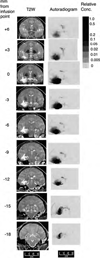Local distribution and toxicity of prolonged hippocampal infusion of muscimol
- PMID: 16381190
- PMCID: PMC4294277
- DOI: 10.3171/jns.2005.103.6.1035
Local distribution and toxicity of prolonged hippocampal infusion of muscimol
Abstract
Object: The activity of gamma-aminobutyric acid (GABA), the principal inhibitory neurotransmitter, is reduced in the hippocampus in patients with complex partial seizures from mesial temporal sclerosis. To provide preliminary safety and distribution data on using convection-enhanced delivery of agents to treat complex partial seizures and to test the efficacy and safety of regional selective neuronal suppression, the authors infused muscimol, a GABA-A receptor agonist, directly into the hippocampus of nonhuman primates using an integrated catheter electrode.
Methods: Ten rhesus monkeys were divided into three groups: 1) use of catheter electrode alone (four monkeys); 2) infusion of escalating concentrations of muscimol followed by vehicle (three monkeys); and 3) infusion of vehicle and subsequent muscimol mixed with muscimol tracer (three monkeys). Infusions were begun 5 days after catheter electrode placement and continued for 5.6 days before switching to the other agent. Head magnetic resonance (MR) images and electroencephalography recordings were obtained before and during the infusions. Brain histological studies and quantitative autoradiography were performed. Neurological function was normal in controls and when muscimol concentrations were 0.125 mM or less, whereas higher concentrations (0.5 and 1 mM) produced reversible apathy and somnolence. Fluid distribution was demonstrated on MR images and muscimol distribution was demonstrated on autoradiographs throughout the hippocampus and adjacent white matter.
Conclusions: Targeted modulation of neuronal activity is a reasonable research strategy for the investigation and treatment of medically intractable epilepsy.
Figures








References
-
- Alvarez-Royo P, Clower RP, Zola-Morgan S, Squire LR. Stereotaxic lesions of the hippocampus in monkeys: determination of surgical coordinates and analysis of lesions using magnetic resonance imaging. J Neurosci Methods. 1991;38:223–232. - PubMed
-
- Baraczka K, Sperk G. Measurement of gamma-aminobutyric acid in human cerebrospinal fluid: radioreceptor assay using [3H] muscimol. Clin Chim Acta. 1991;109:77–82. - PubMed
-
- Baraldi M, Grandison L, Guidotti A. Distribution and metabolism of muscimol in the brain and other tissues of the rat. Neuropharmacology. 1979;18:57–62. - PubMed
-
- Bird RB, Stewart WE, Lightfoot EN. Transport Phenomena. New York: John Wiley & Sons; 1960.
MeSH terms
Substances
Grants and funding
LinkOut - more resources
Full Text Sources
Other Literature Sources
Medical

